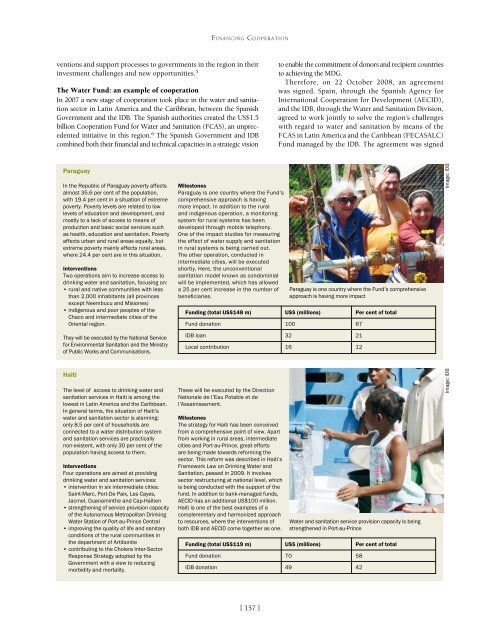Free Flow
oJhBl
oJhBl
Create successful ePaper yourself
Turn your PDF publications into a flip-book with our unique Google optimized e-Paper software.
Financing Cooperation<br />
ventions and support processes to governments in the region in their<br />
investment challenges and new opportunities. 5<br />
The Water Fund: an example of cooperation<br />
In 2007 a new stage of cooperation took place in the water and sanitation<br />
sector in Latin America and the Caribbean, between the Spanish<br />
Government and the IDB. The Spanish authorities created the US$1.5<br />
billion Cooperation Fund for Water and Sanitation (FCAS), an unprecedented<br />
initiative in this region. 6 The Spanish Government and IDB<br />
combined both their financial and technical capacities in a strategic vision<br />
to enable the commitment of donors and recipient countries<br />
to achieving the MDG.<br />
Therefore, on 22 October 2008, an agreement<br />
was signed. Spain, through the Spanish Agency for<br />
International Cooperation for Development (AECID),<br />
and the IDB, through the Water and Sanitation Division,<br />
agreed to work jointly to solve the region’s challenges<br />
with regard to water and sanitation by means of the<br />
FCAS in Latin America and the Caribbean (FECASALC)<br />
Fund managed by the IDB. The agreement was signed<br />
Paraguay<br />
In the Republic of Paraguay poverty affects<br />
almost 35.6 per cent of the population,<br />
with 19.4 per cent in a situation of extreme<br />
poverty. Poverty levels are related to low<br />
levels of education and development, and<br />
mostly to a lack of access to means of<br />
production and basic social services such<br />
as health, education and sanitation. Poverty<br />
affects urban and rural areas equally, but<br />
extreme poverty mainly affects rural areas,<br />
where 24.4 per cent are in this situation.<br />
Interventions<br />
Two operations aim to increase access to<br />
drinking water and sanitation, focusing on:<br />
• rural and native communities with less<br />
than 2,000 inhabitants (all provinces<br />
except Neembucu and Misiones)<br />
• indigenous and poor peoples of the<br />
Chaco and intermediate cities of the<br />
Oriental region.<br />
They will be executed by the National Service<br />
for Environmental Sanitation and the Ministry<br />
of Public Works and Communications.<br />
Milestones<br />
Paraguay is one country where the Fund’s<br />
comprehensive approach is having<br />
more impact. In addition to the rural<br />
and indigenous operation, a monitoring<br />
system for rural systems has been<br />
developed through mobile telephony.<br />
One of the impact studies for measuring<br />
the effect of water supply and sanitation<br />
in rural systems is being carried out.<br />
The other operation, conducted in<br />
intermediate cities, will be executed<br />
shortly. Here, the unconventional<br />
sanitation model known as condominial<br />
will be implemented, which has allowed<br />
a 25 per cent increase in the number of<br />
beneficiaries.<br />
Paraguay is one country where the Fund’s comprehensive<br />
approach is having more impact<br />
Funding (total US$148 m) US$ (millions) Per cent of total<br />
Fund donation 100 67<br />
IDB loan 32 21<br />
Local contribution 16 12<br />
Image: IDB<br />
Haiti<br />
The level of access to drinking water and<br />
sanitation services in Haiti is among the<br />
lowest in Latin America and the Caribbean.<br />
In general terms, the situation of Haiti’s<br />
water and sanitation sector is alarming:<br />
only 8.5 per cent of households are<br />
connected to a water distribution system<br />
and sanitation services are practically<br />
non-existent, with only 30 per cent of the<br />
population having access to them.<br />
Interventions<br />
Four operations are aimed at providing<br />
drinking water and sanitation services:<br />
• intervention in six intermediate cities:<br />
Saint-Marc, Port-De Paix, Les Cayes,<br />
Jacmel, Ouanaminthe and Cap-Haïtien<br />
• strengthening of service provision capacity<br />
of the Autonomous Metropolitan Drinking<br />
Water Station of Port-au-Prince Central<br />
• improving the quality of life and sanitary<br />
conditions of the rural communities in<br />
the department of Artibonite<br />
• contributing to the Cholera Inter-Sector<br />
Response Strategy adopted by the<br />
Government with a view to reducing<br />
morbidity and mortality.<br />
These will be executed by the Direction<br />
Nationale de l’Eau Potable et de<br />
l’Assainissement.<br />
Milestones<br />
The strategy for Haiti has been conceived<br />
from a comprehensive point of view. Apart<br />
from working in rural areas, intermediate<br />
cities and Port-au-Prince, great efforts<br />
are being made towards reforming the<br />
sector. This reform was described in Haiti’s<br />
Framework Law on Drinking Water and<br />
Sanitation, passed in 2009. It involves<br />
sector restructuring at national level, which<br />
is being conducted with the support of the<br />
fund. In addition to bank-managed funds,<br />
AECID has an additional US$100 million.<br />
Haiti is one of the best examples of a<br />
complementary and harmonized approach<br />
to resources, where the interventions of<br />
both IDB and AECID come together as one.<br />
Water and sanitation service provision capacity is being<br />
strengthened in Port-au-Prince<br />
Funding (total US$119 m) US$ (millions) Per cent of total<br />
Fund donation 70 58<br />
IDB donation 49 42<br />
Image: IDB<br />
[ 157 ]


